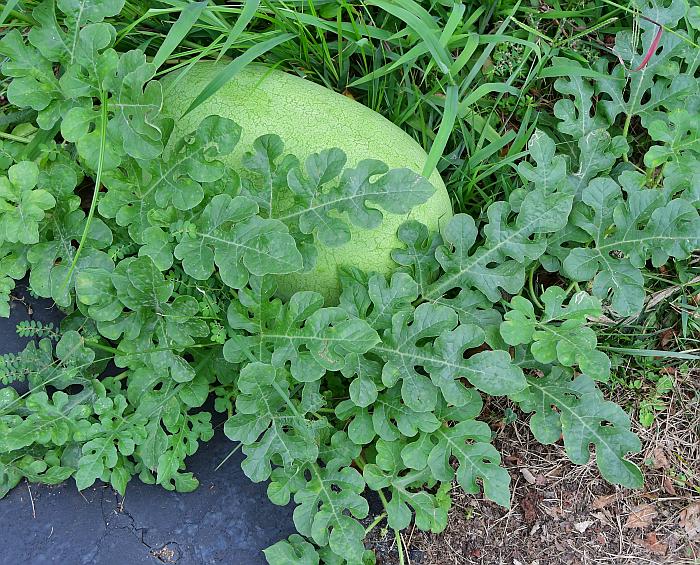Citrullus lanatus (Thunb.) Matsum. & Nakai
Watermelon

Introduced
CC = *
CW = 3
MOC = 14
© SRTurner
Citrullus lanatus (Thunb.) Matsum. & NakaiWatermelon | |
 |
Introduced CC = * CW = 3 MOC = 14 |
© SRTurner |
|
Family - Cucurbitaceae Habit - Taprooted, monoecious annual vine. Stem - Prostrate, vining and trailing, to 4 m or more long, relatively stout (2-5 mm in diameter, at least toward the base), densely pubescent with relatively long, spreading hairs (these often sparse on older growth), not roughened, with branched tendrils at nodes.
Leaves - Alternate, petiolate. Petioles 1.5-15.0 cm long, with moderate to dense, spreading hairs. Leaf blades 4-20 cm long, 3-18 cm wide, triangular-ovate to more or less heart-shaped in outline, deeply and irregularly pinnately divided with 5-11 main lobes, at least the lowermost divisions again deeply lobed, the ultimate lobes obovate to oblong or semicircular, with rounded to bluntly or sharply pointed tips and usually narrowly rounded sinuses, cordate at the base, the margins otherwise irregularly and finely scalloped or toothed, the surfaces slightly to moderately roughened with shorter and longer, mostly pustular-based hairs, 1 or both surfaces often appearing gray or grayish-tinged.
Inflorescence - Flowers solitary in the leaf axils, the stalks of the pistillate flowers 2-12 mm long, those of the staminate flowers 6-30 mm long. Flowers - Calyx lobes 2-12 mm long. Corollas 15-30 mm wide, broadly bell-shaped to nearly saucer-shaped, the 5 lobes 7-15 mm long, yellow. Staminate flowers with the stamens distinct. Stamens 5 but often appearing as 3 due to fusion of 2 pairs. Anthers facing outward, convoluted. Pistillate flowers with 3 small staminodes, the ovary with numerous ovules per placenta, the stigma 3-lobed or more or less 6-lobed.
Fruits - Solitary, juicy berries 5-50 cm long (much larger in some cultivated plants), the rind usually relatively thick, indehiscent, oblong-elliptic to nearly spherical, with a stalk 12-35 mm long, the surface usually green with irregular longitudinal stripes, smooth, glabrous, usually dull. Seeds numerous, 10-15 mm long, 6-9 mm wide, elliptic-obovate to obovate in outline, usually with a pair of slightly swollen patches at the base, flattened, mostly rounded at the tip, the surface smooth, black or brown with black mottling or spots, rarely ivory-colored, usually shiny.
Flowering - May - October. Habitat - Streambanks, railroads, roadsides, open disturbed areas. Widely cultivated in numerous horticultural forms. Origin - Native to Africa. Lookalikes - Flowering plants are similar to other cucurbit species, though the leaves are distinctive. Other info. - The fruit of this plant needs no introduction, and there is no substitute for a thick, ice-cold slab of it after any form of exertion during one of Missouri's hot, humid summer days. The plant is found wild only sporadically, and then usually indicates recent human or animal consumption of the fruit as described above. There are numerous cultivars which vary in many aspects of rind, flesh, and seed color, time to maturity, disease resistance, growth habit, etc. Sterile triploids which are seedless are also available. Watermelons have been cultivated for centuries, and were well established in North American by the time of European settlement. Photographs taken near Labadie, Franklin County, MO, 9-3-2021 (SRTurner). |